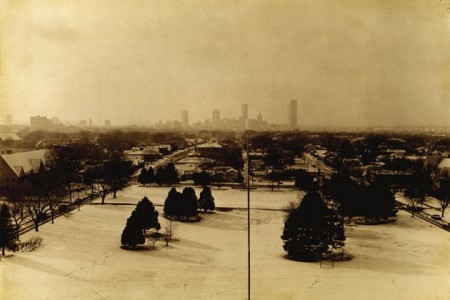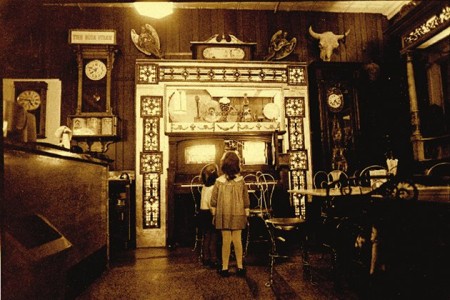In the early 1970s, a twenty-two year-old Lebanese immigrant trekked down the sidewalks of Sixth Street from his West Tulsa apartment to the University of Tulsa. As he crossed Peoria each day, the student traveled where thousands of Tulsa pioneers had walked before. The decayed string of Plains Commercial-style buildings gave little clue as to the ghosts of the street’s historical past.
Khaled Rahhal came to Tulsa with mixed feelings.
“It was not a happy time—I did not want to be here,” he said. “In Lebanon I was to start law school while at the University of Tulsa. I was a freshman. I was afraid I had made a mistake.”
His economic future was as uncertain and undefined as the city itself.
The story of Sixth Street began soon after the 1901 discovery of oil in Red Fork just across the Arkansas River. Tacna manufacturing and industrial businesses developed north of Sixth within sight of the groaning railroads near downtown. Determined to avoid the economic trap of being a one-industry town, a civic Commercial Club offered monetary bonuses and partial moving expenses to attract manufacturing companies. By 1911, the factory area included a glass company and a cotton oil business as well as a canning company and a broom factory.

A view of Tulsa from the University Campus between Fifth and Sixth streets. Taken from McFarlin Library tower window, 1977. Photo courtesy G.Oscar Images.
By 1910, both sides of Sixth Street supported flourishing businesses: a blacksmith, a machine shop, various oil companies and related businesses, a wire fence warehouse and several lumberyards. Sixth Street was taking shape.
With the annexation of the area east of downtown, Tulsa doubled in size to 20,000. East-West streets in the new district were named after trees and the main street along their western origins was Pearl Street. Continuing the established Tulsa downtown format of numbered streets and eastern US cities, Cedar Street became Sixth, and Pearl became Peoria.
From Sixth and Peoria eastward, businesses replaced residences and provided the needed infrastructure for the exploding population. The Colonial Grocery and rival Barrel Food Grocers were side by side. A confectioner plied his trade as the Dixie Bar down the block served thirsty patrons celebrating the end of the workday.
Bill and Bud’s Phillips 66 gas station on the northeast corner of Peoria shared the north side of the avenue with a cafe, a barbershop, a drug store and a garage. The hard-working population crowded the stores and shops along the corridor.
An ingenious scheme to finance the purchase of the land for Tulsa’s first Factory Addition just north of Sixth included an auction of 135 lots. A Tulsa Daily Democrat ad promoting the auction offered “every fifth lady buying a lot a five dollar dress pattern and to every fifth gentleman a five dollar hat.”
Metal workers, carpenters and clerks working in neighboring industries lived in the houses on these parcels. New workers poured into the neighborhood. The influx of their children and increasing numbers of births prompted the construction of Longfellow School in 1913.
Several blocks before Sixth intersects with Lewis, a building stands that once housed George Wallace’s Oklahoma Presidential campaign headquarters. Across the street is a former residence of the Perryman family, prominent Creek settlers whose land holdings became downtown Tulsa.
Not much further east of Lewis was the site of a bustling open-air lumberyard, where two brothers in the 1920s erected a commercial ice-making house. Frosted plumes escaped heavenwards from the ventilation system as locals rolled up to the west loading dock to cart off ice. Tulsa Ice Co. employees slid hefty ice blocks into delivery trucks. Eventually, advances in refrigeration put the icehouse out of business, and the building became a warehouse.
Although pedestrian traffic dominated Sixth, people also boarded horse-driven trolleys and, later, the Tulsa Street Railroad trolleys connecting residential areas to factories and shopping venues. Removed for scrap metal during World War I, trolley life disappeared.
“Sixth Street is a uniquely Tulsa mixture of bootstrap, self-made identities with free-wheeling ambitions and personal respect,” says Dean Williams, a Sixth Street resident. “It seems especially American to me.”
Williams has a point: you can read America’s story simply by looking at Sixth. During the Great Depression, businesses evaporated and the financial distress decimated the once teeming shops. After World War II, the migration to the suburbs nearly emptied the densely populated district. Automobiles became part of every family unit and mobility was no longer limited to rail transportation or foot travel. Shopping centers with convenient parking changed Tulsans’ habits. Life along Sixth crumbled. Blight overtook the once proud thoroughfare.
***
Khaled Rahhal has owned the Eclipse bar and music venue at Sixth and Quaker for decades, as well as a diner that was his first acquistion. Rahhal became fascinated with this area forty years ago, “Long before I could afford to buy a soda pop.”
The old bar next door to his diner became available and he bought it.
“My dream started to come to life,” he says.
Rahhal firmly believes the time for Sixth Street has finally arrived and he has a plan in place. He is not alone.
More than a decade ago, a band of locals formed the Sixth Street Neighborhood Association. Five years later, the group reorganized as the Pearl District Association made up of dedicated Tulsans who defined the organization’s mission as “reinventing the art of city life in Tulsa.”
After years of planning, changes are in store for the west end of Sixth. A retention pond called the West Pearl Pond will corral storm water to eliminate flood zone concerns. Dramatic improvements to the Sixth and Peoria intersection and several blocks east of Peoria will help transform Sixth Street into a “living street” that makes it more pedestrian oriented. Using newly designed building codes, proposed plans create pedestrian-friendly spaces including a water canal and a brick street that will be well situated for special events, outdoor dining and music.
Shelby Navarro and his wife Rachel are part of that plan. He’s an architect with downtown renovation credits and Rachel works with him as a Certified Public Accountant. Among their other Pearl District business interests is the ornate building on Sixth at Quaker, built by Everett House in the early 1920s. A wine bar and art shop are slated to open in what was formerly a drug store. A record production company for Tulsa musicians and a retail music venue will occupy two other spaces.
The Navarros also own the building across the street on the corner of Sixth and Peoria. Restaurateur Blake Ewing – a Blue Dome District kingpin – will soon open a new dining spot: the Phoenix.
The restaurant’s name fits. Like the mythological bird that rose from the fiery ashes, Sixth Street, for too long a stained symbol of the past, is poised to regain its splendor.
Shelby Navarro smiles as he confesses, “It’s a beautiful nighttime sight to look west down Sixth Street.”

